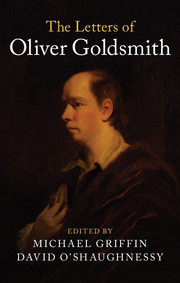2 - To the Reverend Thomas Contarine, Edinburgh, 8 May 1753
Summary
An uncle by marriage, the Reverend Thomas Contarine (c. 1684–1758) was also Goldsmith's most reliable financial support while the latter was a student in Dublin, in Edinburgh, and during his Continental travels. The grandson of a Contarini of Venice – one of the city's most noble families, contributing several Doges of the Venetian Republic – Contarine married Charles Goldsmith's sister Jane and became prebend of Oran, near Elphin, where he had a reasonable living, and kept a good library (which was at the disposal of his nephew while he was a student). According to an anecdote and memoir of Berkeley with which Goldsmith furnished the Weekly Magazine (1759–60), Contarine recounted to the author (Goldsmith) his witnessing of Berkeley's experimental and dangerous investigation of the effects of hanging in his rooms at Trinity. Much respected in the region, Contarine was also friendly with Charles O’Conor (1710–91), the antiquarian and historian of Gaelic Ireland, at whose house a very young Goldsmith may have met the harper Turlough O’Carolan (1670–1738), about whom Goldsmith would write an essay for the British Magazine in July 1760. Contarine's daughter Jane, later Jane Lawder (see Letter 10), would also be a correspondent of Goldsmith’s, and he relays his love for his cousin and her husband in his first postscript below.
The copy-text is a facsimile photostat of the manuscript in the Huntington Library, California. The present location of the original manuscript is unknown. It was first published by Prior in 1837. It is addressed ‘To | The Revd. Mr. Thos: Contarine | at Kilmore near Carick on | shannon in | Ireland. [Via] London’ and postmarked 14 May.
- Type
- Chapter
- Information
- The Letters of Oliver Goldsmith , pp. 4 - 7Publisher: Cambridge University PressPrint publication year: 2018



